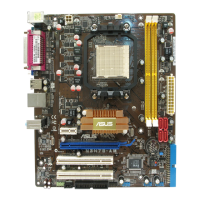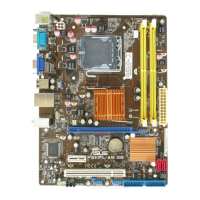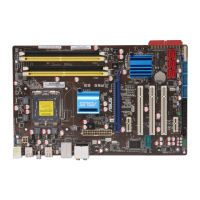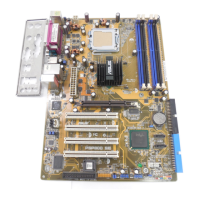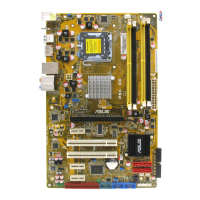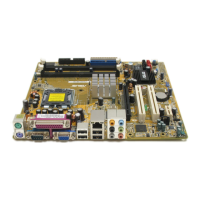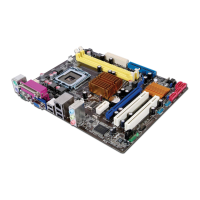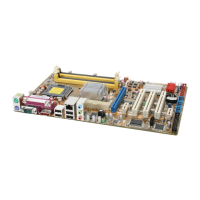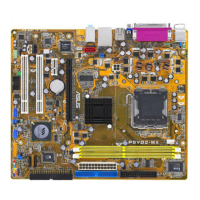Do you have a question about the Asus P5GPL-X SE and is the answer not in the manual?
Describes FCC compliance and regulations for the device.
Describes Canadian compliance and radio noise regulations.
Guidelines for safe handling of electrical components and system.
Best practices for safe system operation, handling, and environment.
Explains the organization of the manual's chapters and content.
Points to resources for further product details and updates.
Explains symbols used for warnings, cautions, and important notes.
Describes formatting for menus, keys, commands, and text emphasis.
A greeting to the user for purchasing the ASUS motherboard.
Lists all items included in the motherboard package for user verification.
Details significant features and technologies of the motherboard.
Essential steps and warnings before installing hardware components.
Explains the function of the motherboard's standby power LED.
Ensures correct orientation and fit within the chassis before installation.
Instructions for using screw holes to mount the board to the chassis.
Step-by-step instructions for installing a CPU into the socket.
Identifies the location and type of memory sockets on the motherboard.
Recommends settings for optimal memory performance and compatibility.
General steps for adding expansion cards to motherboard slots.
Adjusting software settings for expansion cards after installation.
Procedure to reset BIOS settings by clearing the CMOS RAM via jumper.
Details on PS/2, Parallel, LAN, Audio, and USB ports on the rear panel.
Describes the IDE interface for connecting storage devices.
Steps to create a DOS bootable disk for BIOS utilities.
How to set the system's clock and calendar within the BIOS.
Setting the type of floppy drive installed in the system.
BIOS settings for CPU frequency, voltage, and overclocking.
Settings for system sleep states (ACPI, APM).
Video behavior upon resuming from S3 sleep state.
Setting the order of boot devices for system startup.
Setting and managing the BIOS supervisor password.
Procedures for saving changes and exiting the BIOS setup.
Requirements for installing an operating system on the motherboard.
Overview of the drivers, applications, and utilities on the support CD.
How to launch the support CD interface and install software.
Details on the motherboard's compatibility with Intel EM64T 64-bit technology.
Prerequisites for using Enhanced Intel SpeedStep Technology (EIST).
Instructions for enabling and utilizing Intel Hyper-Threading Technology.
Describes FCC compliance and regulations for the device.
Describes Canadian compliance and radio noise regulations.
Guidelines for safe handling of electrical components and system.
Best practices for safe system operation, handling, and environment.
Explains the organization of the manual's chapters and content.
Points to resources for further product details and updates.
Explains symbols used for warnings, cautions, and important notes.
Describes formatting for menus, keys, commands, and text emphasis.
A greeting to the user for purchasing the ASUS motherboard.
Lists all items included in the motherboard package for user verification.
Details significant features and technologies of the motherboard.
Essential steps and warnings before installing hardware components.
Explains the function of the motherboard's standby power LED.
Ensures correct orientation and fit within the chassis before installation.
Instructions for using screw holes to mount the board to the chassis.
Step-by-step instructions for installing a CPU into the socket.
Identifies the location and type of memory sockets on the motherboard.
Recommends settings for optimal memory performance and compatibility.
General steps for adding expansion cards to motherboard slots.
Adjusting software settings for expansion cards after installation.
Procedure to reset BIOS settings by clearing the CMOS RAM via jumper.
Details on PS/2, Parallel, LAN, Audio, and USB ports on the rear panel.
Describes the IDE interface for connecting storage devices.
Steps to create a DOS bootable disk for BIOS utilities.
How to set the system's clock and calendar within the BIOS.
Setting the type of floppy drive installed in the system.
BIOS settings for CPU frequency, voltage, and overclocking.
Settings for system sleep states (ACPI, APM).
Video behavior upon resuming from S3 sleep state.
Setting the order of boot devices for system startup.
Setting and managing the BIOS supervisor password.
Procedures for saving changes and exiting the BIOS setup.
Requirements for installing an operating system on the motherboard.
Overview of the drivers, applications, and utilities on the support CD.
How to launch the support CD interface and install software.
Details on the motherboard's compatibility with Intel EM64T 64-bit technology.
Prerequisites for using Enhanced Intel SpeedStep Technology (EIST).
Instructions for enabling and utilizing Intel Hyper-Threading Technology.
| Number of memory slots | 2 |
|---|---|
| Maximum internal memory | 2 GB |
| Processor socket | LGA 775 (Socket T) |
| Processor manufacturer | Intel |
| S/PDIF out connector | Yes |
| Number of SATA connectors | 4 |
| Number of EATX power connectors | 1 |
| USB 2.0 ports quantity | USB 2.0 ports have a data transmission speed of 480 Mbps, and are backwards compatible with USB 1.1 ports. You can connect all kinds of peripheral devices to them. |
| Motherboard form factor | ATX |
| Bundled software | Drivers ASUS PC Probe ASUS LiveUpdate Utility Anti-virus software |
| LAN controller | Marvell 88E8001 |
| Networking features | Ethernet / Fast Ethernet |
| BIOS memory size | 32 Mbit |
| Depth | 183 mm |
|---|---|
| Width | 305 mm |

